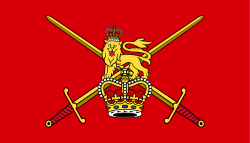| British Army Germany | |
|---|---|
 British Army Germany badge | |
| Active | 2020–present |
| Country | Germany |
| Allegiance | |
| Branch | |
| Type | Headquarters, British Army Germany |
| Role | Military command, support, and administration |
| Part of | British Armed Forces, UK Ministry of Defence |
| Commanders | |
| Current commander | Colonel Mike Foster-Brown [1] |
 |
| British Army of the British Armed Forces |
|---|
| Components |
| Administration |
| Overseas |
| Personnel |
| Equipment |
| History |
| Location |
| United Kingdom portal |
British Army Germany (BAG) is the superior institution under which the remaining installations of the former British Forces Germany (BFG) are organised after the completion of the withdrawal of the British Armed Forces from Germany in February 2020. Apart from the Alpine Training Centre Bavaria in Oberstdorf, which is in Bavaria, British Army Germany is entirely based in North Rhine-Westphalia.